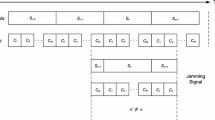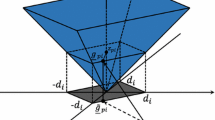Abstract
The deceptively simple problem of a single inverted reflection in ordinary frequency modulated (FM) radio is considered. It will be shown that this problem has been overlooked in the literature and causes major breakdown in reception. The problem is known as suppressed-carrier AM-FM (SCAM-FM) and is totally destructive to the received signal. We examine the theory and practical measurements of SCAM and show a solution for reducing its effect.

















Similar content being viewed by others
References
Corrington, M. S. (1945). Frequency modulation distortion caused by multi-path transmission. Proceedings of the IRE, 30, 878–891.
Kammeyer, K. D. (1985). Equalization problems in digital FM receiver. Signal Processing, 9, 263–276.
Kammeyer, K. D., Mann, R., & Toberegt, W. (1987). A modified adaptive FIR equalizer for multipath echo cancellation in FM transmission. IEEE Journal, Selected areas of Communications, SAC–5(2), 226–237.
Tingley-Robert, D. (1997). Reducing multipath fading using adaptive filtering. US Patent application No US/08/307300, Filed 16th Sept 1994 issued 9th Dec.
Schnepp, H., Muller, T. & Luy, J.-F. (2001). Channel-diversity in software autoradio. In Proceedings vehicular technology conference, VTC-Spring, Rhodes, Greece.
Treichler, J. R., & Agee, B. G. (1983). A new approach to multipath correction of constant modulus signals. IEEE Transactions on ASSP, 31(2), 459–472.
Moir, T. J. (1995). Analysis of an amplitude-locked loop. Electronics Letters, 31(9), 694–695.
Pettigrew, A. M., & Moir, T. J. (1993). Coherent demodulation of DSSC without pilot tone using the amplitude-locked loop. Journal of the Audio Engineering Society, 41(12), 998–1007.
Pettigrew, A. M., & Moir, T. J. (1991). Reduction of FM threshold effect by In-band noise cancelling. Electronics Letters, 27(12), 1082–1084.
Clark, D. F., & Moir, T. J. (1999). Application of a PLL and ALL noise reduction process in optical sensing systems. IEEE Transactions on Industrial Electronics, 44(1), 136–138.
Reed, J. H. (2002). Software radio: A modern approach to radio engineering. Englewood Cliffs: Prentice Hall Professional.
Author information
Authors and Affiliations
Corresponding author
Appendices
Appendix 1. Simplification of \(\psi (t)\)
The difference frequency function is given by (16)
Now the fist sine term in (34) can be written as
which approximates for small angles of \(k=\frac{\pi \omega _m }{\omega _c }\) to be
Adding all terms gives in (34)
or
Ignoring the second term above as it will be small we get the result
When taking the cosine of \(\psi (t)\) we can simplify accordingly
and this can be further simplified for small angles to be
Hence this function is related to twice the modulating frequency.
Appendix 2. Differentiation of \(\frac{d}{dt}\tan ^{-1}\left[ \frac{m\sin (\psi (t))}{1+m\cos (\psi (t))}\right] \)
Recall that the differentiation of \(\frac{d}{dt}\tan ^{-1}[f(t)]=\frac{1}{1+[f(t)]^{2}}f^{{\prime }}(t)\) where the shorthand notation is used here \(f^{{\prime }}(t)=\frac{d}{dt}f(t)\).
To differentiate a function of the form \(\frac{u(t)}{v(t)}\) we use the quotient rule
so that
Now
so that its derivative is given by
hence
Rights and permissions
About this article
Cite this article
Moir, T.J., Pettigrew, A.M. A Multiplicative Cancellation Approach to Multipath Suppression in FM Radio. Wireless Pers Commun 75, 799–819 (2014). https://doi.org/10.1007/s11277-013-1392-5
Published:
Issue Date:
DOI: https://doi.org/10.1007/s11277-013-1392-5




